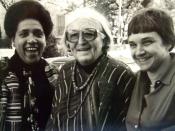For centuries, the role of women in society has been carefully defined by a patriarchal sociological system. Up until the 1960's it was considered a woman's national duty to reproduce and her primary function in life. To consciously limit the number of children that they had meant not only were women going against their natural function, but failing in that national duty (Currie & Adamson, 1977). Women have had to fight for the right to vote, which only occurred in Australia in 1902 (Currie & Adamson, 1977), and were denied the right to education, especially tertiary education. Even after this right was won, there were still fears being voiced about the bad effects on girls at school from bending over desks and being strained by thinking (Currie & Adamson, 1977). This strength should be saved for motherhood. Even today, women are still a disadvantaged group. Expectations on what a woman's role should be, especially in the family unit, still influence choices that women make, and the importance of their personal preferences are diminished.
In Australia, women were brought to essentially service the sexual needs of the males in the colony, and were then condemned for their behaviour (Summers, 1975). In the 19th century, debates continued over whether women were legal 'persons', able to own property, have custody of children, or receive formal education. Many of these arguments reflected specific Western assumptions that to be a 'person', was to be a 'rational' individual, and women were seen as essentially emotional (Reiger, cf. Kellehear, 1995). Women were then compelled to rely for their social status on the position of husband's and fathers in society. Still, women receive 30-40% less pay than men if employed (Doyal, 1996) and remain unpaid for work within the family unit. Women may be revered as mothers, or...


